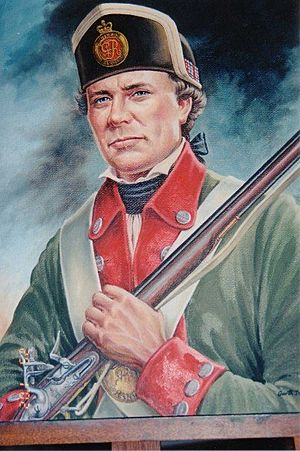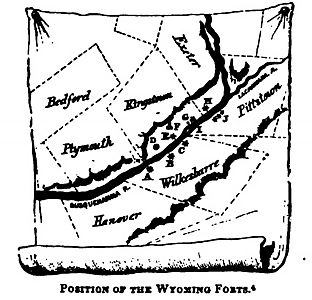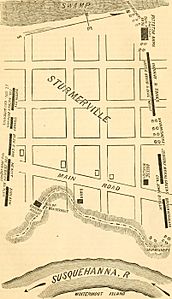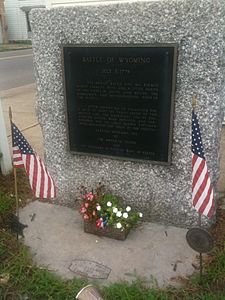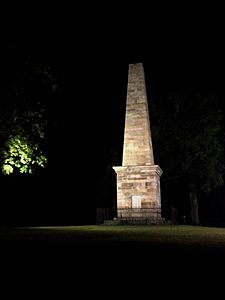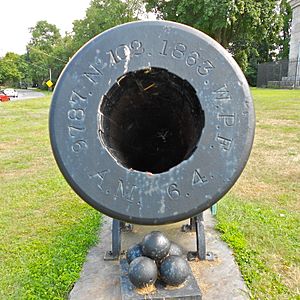Battle of Wyoming facts for kids
Quick facts for kids Battle of Wyoming Valley |
|||||||
|---|---|---|---|---|---|---|---|
| Part of the American Revolutionary War | |||||||
|
|||||||
| Belligerents | |||||||
Iroquois |
|||||||
| Commanders and leaders | |||||||
Sayenqueraghta Cornplanter |
|||||||
| Strength | |||||||
| 110 Butler's Rangers 464 Iroquois (primarily Seneca, but also Cayuga, Onondaga, Lenape, and Tuscarora) |
360 (24th regiment Connecticut militia, detachment of Continentals, Wyoming riflemen) |
||||||
| Casualties and losses | |||||||
| 3 killed 8 wounded |
about 340 killed 5-20 captured |
||||||
| 360 American civilians massacred; many others died of starvation or exposure | |||||||
The Battle of Wyoming (also called the Wyoming Massacre) was a fight during the American Revolutionary War. It happened between American soldiers, called Patriots, and British supporters, known as Loyalists. Native American Iroquois warriors also joined the Loyalists.
This battle took place in the Wyoming Valley of Pennsylvania on July 3, 1778. It happened near the towns of Exeter and Wyoming, Pennsylvania. More than 300 Patriots were killed during the battle. After the fighting, many settlers, including men, women, and children, lost their lives. Others who tried to escape into the forests died from hunger or cold.
Contents
Why the Battle Happened

In 1777, a British general named John Burgoyne tried to take control of the Hudson River. This was part of the American Revolutionary War. But his plan failed, and he had to surrender in October after the Battles of Saratoga.
When France heard about this, they decided to join the war as an ally of the Americans. The British worried that France might try to take back lands they had lost in an earlier war. So, the British decided to fight a "frontier war." This meant they would attack American settlements along the borders. They got help from Loyalists and Native American allies.
Colonel John Butler gathered a group of Loyalists called Butler's Rangers. Native American chiefs Sayenqueraghta and Cornplanter brought many Seneca warriors. Another leader, Joseph Brant, gathered mostly Mohawks. These groups planned to attack American settlements.
In June 1778, Butler and the Seneca warriors decided to attack the Wyoming Valley. Meanwhile, Brant and the Mohawks planned to attack other settlements further north.
American leaders like George Washington also tried to get Native American tribes to join them. But they had less success. Only the Oneidas and Tuscaroras from the Iroquois Confederacy became allies of the Patriots.
The Battle Begins
The British forces arrived in the Wyoming Valley on June 30. They had already warned the settlers by killing three men on June 28. The next day, Colonel Butler demanded that the local American militia surrender their fort. They agreed to give up their weapons and supplies. In return, they would be set free, promising not to fight again in the war.
However, on July 3, the British saw many American defenders gathering outside another fort called Forty Fort. Colonel Butler decided to set a trap. He ordered Fort Wintermute to be set on fire. The Patriots thought this meant the British were leaving and quickly moved forward.
Butler had the Seneca warriors lie down so they couldn't be seen. The American militia got very close to the British rangers and fired their guns three times. Then, the Seneca warriors stood up, fired their own guns, and rushed into hand-to-hand combat.
Fighting and Aftermath
The battle lasted about 45 minutes. The American militia, who were not very experienced, panicked and started to run away. It became a dangerous race for survival. Only about 60 Patriots managed to escape. The Loyalists and Iroquois killed almost all the captured soldiers. Only five prisoners were taken alive.
The next morning, Colonel Nathan Denison, an American leader, agreed to surrender Forty Fort and two other posts. Colonel Butler let the remaining American soldiers go, as long as they promised not to fight anymore.
After the battle, Colonel John Butler reported that only three of his men were killed. He also claimed his forces burned 1,000 houses and took many animals. Only about 60 of the 300 American militia and 60 other American soldiers escaped. Butler and his forces left the valley and returned to Fort Niagara by mid-July 1778.
Many American settlers fled the valley after the battle. They spread stories about the defeat, which caused fear across New York and Pennsylvania. Some American newspapers even added made-up details. People were very angry about these reports of a massacre. Many saw it as another reason to support American independence.
A few months later, American Colonel Thomas Hartley arrived to defend the valley. He also tried to save some crops. In September, Hartley and his soldiers went up the Susquehanna River. They destroyed Native American villages and took back many stolen goods. They fought with some Native Americans but left when they heard that Joseph Brant was gathering a large force.
The Battle of Wyoming and other attacks encouraged American military leaders to fight back. In the summer of 1779, General George Washington sent the Sullivan Expedition. This group destroyed 40 Iroquois villages and huge amounts of food in upstate New York. The Iroquois tribes were badly hurt by this and many died of hunger that winter. The tribes allied with the British continued to raid American settlements until the war ended.
Remembering the Battle
The Battle of Wyoming and the events that followed were well-known to Americans for a long time. It became important again during the War of 1812, when Americans were fighting the British and Native Americans once more. Some newspapers compared the Battle of Frenchtown in 1813 to the Wyoming Massacre.
A Scottish poet named Thomas Campbell wrote a poem about the massacre in 1809 called "Gertrude of Wyoming". He described Joseph Brant as a "monster" in the poem, but it was later found that Brant was not actually at the battle.
The western state of Wyoming got its name from the U.S. Congress in 1868.
Each year, the Wyoming Commemorative Association holds a ceremony to remember the battle and massacre. This event takes place at the Wyoming Monument, which is a memorial dedicated to the battle. The monument is also a mass grave for many of the victims. These ceremonies started in 1878, for the 100th anniversary of the battle. The President at the time, Rutherford B. Hayes, was the main speaker.
The annual program has continued every year since then. The names of 178 Patriots killed in the battle are listed on the Wyoming Monument. It also lists the names of about a dozen militia members who were killed or died in captivity just before the main battle.
-
The Wyoming Monument
-
Mouth of one of the cannons at the monument
Reenactment of the Battle of Wyoming
Every year around the Fourth of July, the Wyoming community and the Luzerne County Historical Society organize a ceremony. For over 140 years, they have reenacted the battle to remember this important event.


